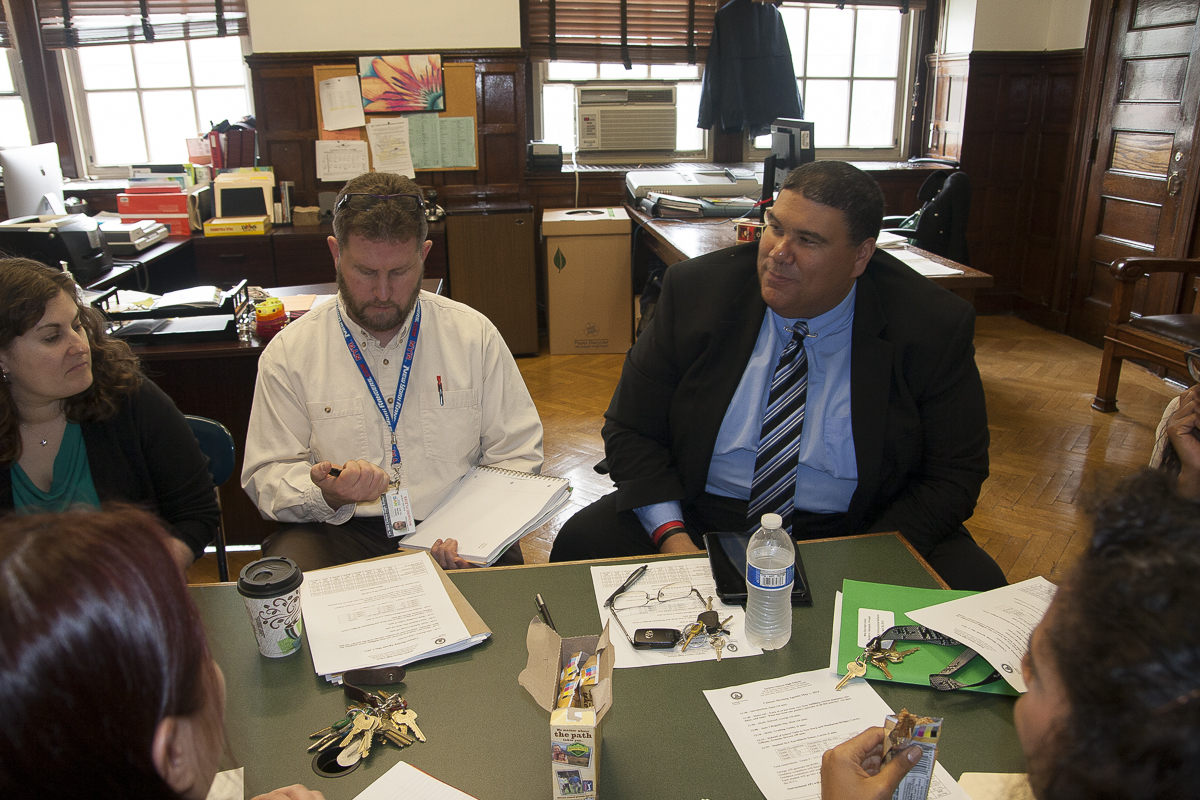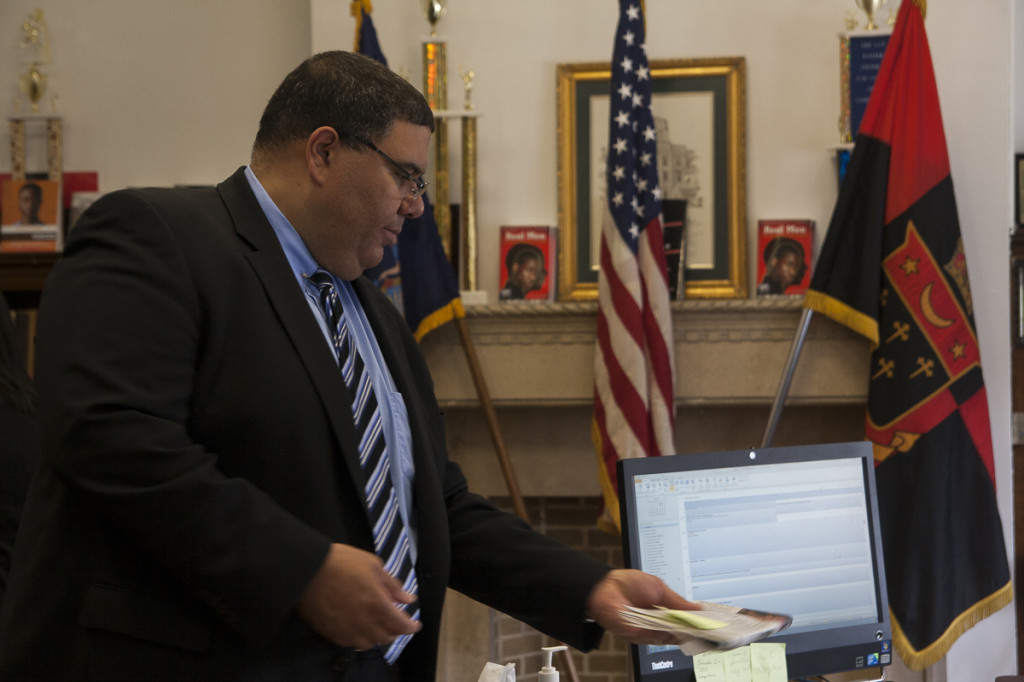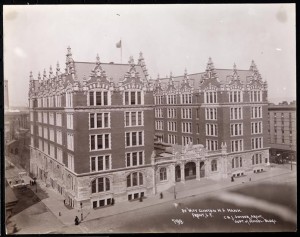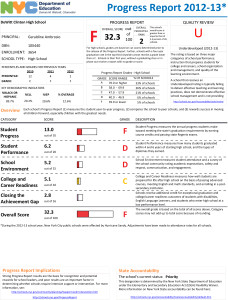
Principal Santiago Taveras came to DeWitt Clinton High School in the Bronx this fall with a big mission: save the school before it simply ceases to exist.
This is personal to Taveras, a towering presence who everybody — students, faculty, and staff alike — calls “Santi.” He grew up in the Bronx, though wound up going to nearby Kennedy High School, instead. “That one was co-ed,” he jokingly explained to a student one day after school. “There weren’t any girls here when I would’ve gone.”
For years now, many top education officials have tried to carve up DeWitt Clinton’s stately building on Mosholu Parkway, nicknamed “the Castle on the Parkway,” into several smaller schools–a fate met by most other big, comprehensive high schools in New York City. Some proposals recommended the school be closed outright.
Taveras’ entrance onto the scene took the school off the chopping block when he arrived on campus as its new principal. Senior Department of Education officials know Taveras well. He is one of them, having moved up through the ranks from classroom teacher all the way to the cabinet of former chancellor Joel Klein. Taveras helped created the new data-based policies and programs that have changed the way schools are evaluated by administrators, teachers, students, and families alike.
Taveras has already witnessed progress in his short time there. Attendance rates are up and more students are passing core classes. He organized the school’s first dances and pep rallies in years, sparking a resurgence of pride in the school among both students and teachers. And he’s spent the year mapping a blueprint for reform–a proposal for five small learning communities, which he hopes will shore up a sense of community at the school battered over the years by a reputation for poor academics and frequent outbursts of violence.
With a reprieve from immediate closure, DeWitt Clinton now faces an even more daunting threat, one that may be far more difficult to combat. The city’s controversial School Progress Report, a Bloomberg-era initiative whose development and rollout Taveras personally oversaw, has listed DeWitt Clinton as an ‘F’ school the past three years — making it next to impossible to attract new students. In fact, its enrollment has collapsed by a couple hundred students each year, followed by cuts to faculty, staff, and programs to compensate for the reduced budget.
The school’s once-storied reputation is now the prime force working against it.
Rebuilding the ‘Castle’
Taveras keeps his schedule clear between 3 and 3:30 every afternoon, leaving behind his administrative duties to chat with students. Rain or shine, searing heat or frigid temperatures, he greets them as they leave the building and scatter toward the nearby Number 4 train, or the bodegas and pizza shops along Jerome Avenue.
One cold day in late March, Taveras entered his office just after dismissal. A lanky student trailed behind him, shivering in a short-sleeved t-shirt. The tall boy seemed to shrink next to Taveras, who towers above just about everyone in the building.
Taveras moved with a contagious urgency. Everyone he passed on the way into his office seemed to talk faster, type faster, finish faster. There was energy in his feet, but his eyes were tired.
The student said he’d lent his jacket to a friend, who had then misplaced it. When Taveras saw him walking home in the cold without one, he’d insisted on bringing him back inside. “Go to my closet and get him a sweater,” Taveras instructed a colleague, who summoned a red, school athletics fleece. The student tugged at the coat’s too-short sleeves and headed out the door. It’s this kind of work, Taveras said, that’s the most rewarding — small changes that can make a big difference for students.
Taveras has built his career on turnaround cases like DeWitt Clinton. He advanced through the ranks from teacher to principal to superintendent, finally landing a spot as an administrator in the Klein administration. He went left the Department of Education to work for Cambridge Education, a consulting firm that specializes in turning around failing schools or districts.
The work was rewarding, but mostly hands-off. Taveras found himself spending less and less time each day interacting with kids. “I would go into a building and I was a stranger,” he said.
When the principal’s post opened up at DeWitt Clinton, Taveras tossed in his name, hoping to return to the energizing, real-time work with students inside schools. He knew he was taking on a school the Department of Education has all but given up on.
The once proud campus had been in a free fall for years. Its academic measures placed it among the bottom 2 percent of the city’s high schools. Only 42 percent of its students graduated in four years in 2012, 20 percent lower than the city average. Students have steadily opted out, leaving the school with larger than average populations of the most challenging students: 17 percent have special needs and 22 percent are still learning English.
 A plan last year would have all but eliminated DeWitt Clinton, turning the massive building into the Clinton Educational Campus, filled with smaller, co-located schools. The effort met significant pushback from the school’s large, engaged alumni network. Alums have won numerous battles against city officials who would, in their eyes, storm the castle and sack its legacy. The outcome was a Pyrrhic victory: they preserved DeWitt Clinton, but the building now hosts two new schools, World View High School and Bronx Collaborative High School, on its third floor. Both schools will grow over the next three years as they add subsequent classes.
A plan last year would have all but eliminated DeWitt Clinton, turning the massive building into the Clinton Educational Campus, filled with smaller, co-located schools. The effort met significant pushback from the school’s large, engaged alumni network. Alums have won numerous battles against city officials who would, in their eyes, storm the castle and sack its legacy. The outcome was a Pyrrhic victory: they preserved DeWitt Clinton, but the building now hosts two new schools, World View High School and Bronx Collaborative High School, on its third floor. Both schools will grow over the next three years as they add subsequent classes.
In Taveras’ view, to save DeWitt Clinton is to restructure it. With more than 2,000 students now, it’s just too big to achieve a vital sense of community. He has spent the year planning five subsets of DeWitt Clinton that would group students and faculty together based on specific academic focuses. The smaller setting will allow students to get to know their teachers and classmates more intimately, which could lead to greater rates of academic success.
“Right now, you look in the hallway and sometimes you don’t know who any of these students are,” said math teacher Howard Stern. “That’s something that will change.”
The new plan builds upon what’s seen by many as DeWitt Clinton’s top asset: the Macy Honors Program. It’s been a factor in attracting students who might otherwise enroll at another public school.
“I know there were better schools for me to go to,” said senior Michael Miranda. “A lot of people said bad things about Clinton, but my brother went there and told me they had a really good honors program. So I said, ‘You know what, I’ll go there.”
Those small communities help students like Michael thrive. With a smaller cohort of students and a dedicated corps of teachers and counselors, students in Macy academically outperform the average DeWitt Clinton student. It’s that kind of success Taveras hopes to replicate with new small learning communities.
“The counselors have been on me ever since I’ve been there,” Miranda said. He arrived at high school as a “very lazy” freshman. But with the help of the Macy faculty he’s learned to channel his energy, he said, “because I know in the real world I can’t just be laid back.”
In addition to the existing honors program, the school will add a house for immigrants who have been in the country less than three years; one focused on the STEM fields of science, technology, engineering, and math; another to prepare students for careers or higher education in health and medicine; and a final focused on business.
It hasn’t been a smooth ride for Taveras to gain momentum for the new, small learning communities. The program is expected to be up and running for next year’s freshman, but more than half of the upperclassmen have not selected a house. Support among the faculty has proven to be even harder to rally.
“What continues to be the biggest challenge is building a sense of community,” Taveras said. “In an organization this big, it’s difficult to bring everyone together at all different levels.”
Most important, the school needs to shake off its current reputation for failure. Taveras appointed a public relations committee of teachers, staff and students to spread the good news about DeWitt Clinton before the city’s eighth graders selected their high schools for next year.
“Let’s get the word out to middle school teachers, guidance counselors, students and their families that DeWitt Clinton High School is on the rise,” Taveras wrote in the March issue of The Clinton News, the school’s century-old student newspaper. “Work hard to promote the wonderful things that are happening at our school.” He cited examples of students receiving prestigious scholarships, and an increased number of social activities, talent shows, and dances.
He hopes these reforms will eventually help to reverse the steady exodus of students. But is it too late?

A school without a moat
When it was dedicated on Oct. 29, 1929, the current DeWitt Clinton High School was hailed as a “temple of education” by then-mayor James J. Walker. The city’s $2.5 million dollar investment, he said, “will well repay us even after we are gone, by training future generations to be good citizens.”
But nearly nine decades later, the school struggles to live up to that legacy.

The metrics used to evaluate DeWitt Clinton’s success are relatively new, but the challenges facing educators are anything but. The vast majority of the student body has long been comprised of students from poor and working-class families, many of them immigrants or the children of immigrants whose life circumstances are challenging. Today, more than three-quarters of students are eligible for free and reduced lunch, a metric tied to low family incomes.
“DeWitt Clinton may have been a ‘Castle on the Parkway,’ but it never had a moat to protect it from the winds of change,” said Gerard Pelisson, a Bronx native and former DeWitt Clinton history teacher who co-authored the definitive history of the school.
“If you want to talk about Stuyvesant or Bronx Science or even Fordham Prep, these are all schools where you took a test and the elite came in,” he said. “DeWitt Clinton was always a school that had to deal with everybody and anybody.”
Though DeWitt Clinton’s student body today — 59 percent Hispanic and 31 percent black — looks different demographically than it did decades ago, the respective student bodies are actually quite similar, Pelisson argued.
“The remarkable thing is when you look at the kids in the school today who are from Ghana and Nigeria and places like that, the only difference between them and the Jews who came from Europe in the ‘30s and ‘40s is their skin color,” Pelisson said.
“The State of Liberty may have welcomed the immigrant, but it was schools like Clinton that gave them the tools to make it home,” he said. “You have generations of people who have come and had this as their introduction to America — and they did pretty well.”
Incremental improvements
Measured against this historical backdrop, DeWitt Clinton’s incremental improvements since Taveras took over could be described as remarkable.
Even so, they are not enough to eradicate its rocky past. This spring, a teacher was arrested, charged with attacking a police officer after getting caught up in a scuffle between students who were fighting, and the school safety officers who were trying to break it up.
What started as an altercation between two male students in late March quickly escalated into what Taveras called race-fueled “near riot” conditions between black and Dominican students at DeWitt Clinton. One fight between two boys, caught on camera, sparked several days of student fighting in between nearly every class period. In the weeks that followed, the “Castle on the Parkway” began to resemble a fortress, with NYPD school safety forces beefed up in an effort to keep hallways orderly and safe. An altercation between two girls ended with the arrest of global studies teacher Jack Israel, who students say stepped in to defend a girl being manhandled by a school safety officer. Israel was hit with a slew of charges, including assault and resisting arrest.
The arrest brought the attention of local News 12 to Clinton’s door. Taveras worries the eruption will overshadow the success the school has made so far this year.
A few days after the arrest, a group of school workers gathered around the principal’s computer after school to watch the coverage. Everyone was concerned with how the school would be portrayed. His brow furrowed, Taveras pulled up a web version of the story. The teachers and administrators gathered around his desk, bracing for the worst.
A short segment played about Israel’s arrest, which included an interview with a student defending him. Several sweeping views of the front doors to DeWitt Clinton later, one administrator quipped, “Well, that wasn’t that bad.”
“It has been emotionally draining,” Taveras said about the week’s events that dragged the school temporarily back to its turbulent past. “And even if this hadn’t happened, we were still not at where we needed to be. It’s still a work in progress. This has set us back a few steps, but we will continue to move forward and get things done.”

Another ongoing source of challenge for DeWitt Clinton is the school’s Progress Report score. The school’s persistently low scores are a primary factor keeping new students away, and a frequent stressor for students and staff, many of whom who see the rating as unfair and inaccurate. The Progress Report and its complementary assessment, the Quality Review, are part of the most controversial legacy of the Klein and Bloomberg era of public education in New York City.
But Taveras says the data proves an invaluable tool for assessing the challenges facing his school. He’s able to zero in on the biggest challenges and develop specific strategies to address them. This year, it’s the low number of students who earn enough credits to advance to the next grade. By the end of the 2012-2013 school year, just 28 percent of freshman had earned the 10 credits needed to advance to the 10th grade.
Another reason Taveras is a fan of the Progress Report? He’s the administrator who developed the rubrics, tested them, and oversaw their rollout citywide. The Quality Report is what Taveras calls a “leading indicator,” meaning it’s a snapshot of what’s happening at a school right now. The Progress Report, a letter grade assigned each year, is a “lagging indicator,” meaning it’s based on data that’s already a year old.
“Principals understand data like the Progress Report because it says a lot about your school,” Taveras said. “And it can help you set priorities as to how you plan for the year.”
A shrinking school
This year, there are about 2,600 students enrolled at the DeWitt Clinton High School, according to Department of Education numbers. Next year, it’ll be just over 2,000, Taveras projects.
That decline in enrollment means the school will lose between $2 and $3 million from its budget next year, forcing administrators to cut staff by up to a third. It will be especially difficult to find “appropriate cuts,” Taveras said, because city contracts require that the newest teachers and staffers be the first to go. That’s troubling, he said, because the newest teachers have been among the most engaged in planning DeWitt Clinton’s future.
“Those people have been involved in all of this,” Taveras said. “They’ve been working all these Saturdays, all these extra hours. And they’ll be the ones excessed.”
Of the teachers left, many will be the ones Taveras has had the most trouble engaging in new school changes like the learning communities. Many are not even checking emails regularly, a particular challenge in a building still not equipped with computers in every classroom.
But perhaps the most important change is a push to celebrate DeWitt Clinton High School itself. One of the first things Taveras did upon his arrival was push for a resurgence of school spirit, resurrecting traditions from the school’s long history. One of the most common phrases echoed throughout the hallways on bulletin boards, handouts, morning announcements and the new flat-screen TVs installed in the building’s lobby is “Sine labore nihil.”
It’s the school’s motto, a Latin phrase that translates to “Nothing is accomplished without hard work.” For Taveras, this is also the philosophy that’s guiding his efforts to revive DeWitt Clinton High School.
“It’s going to be difficult, yes,” Taveras said of the work ahead. “But it’s not impossible.”




Mr. Taveras:…..Yours is a fascinating story, indeed. Clearly, you face many obstacles in your quest but your motivation dedicated and powerful. This coming June will be the 64th anniversary of my graduation and I have been trying, without much success to contact the office of the Clinton News, where I was the PhotoEditor for the News in both ’50 and ’51. I have several sports pictures that might be historically interesting to some of your population. I do not know how to contact the papers’ office and, if you wish, I would be pleased to e-mail the images to you, or someone else of your choosing. Hoping to hear back from you.
Victor M. Linn
Mobile phone 917-853-7213